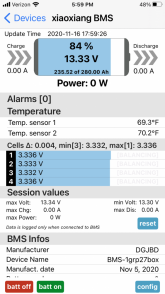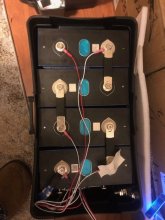Greetings,
So I recently received 8, 280Ah cells from Basen and started the process of getting ready to assemble 2, 4s 12v batteries. I started the top balance process with 4 cells but the volt meter was set too high. The power supply I have has a free spinning volt dial and the display would not go above 3.5v at 10 amps while the batteries were at 3.3v. but it was apparent that the setting was higher than that because once the cells were charged the voltage jumped up. Anyway I was watching the process and checked and the cells were at 3.3v, I went away for about an hour and came back to cells at 4.4v., well above the 3.65 max recommended. I immediately disconnected the power supply and assembled the batteries in 4s and put a draw on them. The volts came back down to normal pretty quickly. here is shot of the BMS app:

All seems good but all cells now have a bit of bloat to them, they were perfectly flat when arrived. not sure if you can tell but here is a top down shot:

You can see the gaps between the cells from the bloat.
So my question is: How bad did I screw up my cells??
Thanks,
RC
So I recently received 8, 280Ah cells from Basen and started the process of getting ready to assemble 2, 4s 12v batteries. I started the top balance process with 4 cells but the volt meter was set too high. The power supply I have has a free spinning volt dial and the display would not go above 3.5v at 10 amps while the batteries were at 3.3v. but it was apparent that the setting was higher than that because once the cells were charged the voltage jumped up. Anyway I was watching the process and checked and the cells were at 3.3v, I went away for about an hour and came back to cells at 4.4v., well above the 3.65 max recommended. I immediately disconnected the power supply and assembled the batteries in 4s and put a draw on them. The volts came back down to normal pretty quickly. here is shot of the BMS app:

All seems good but all cells now have a bit of bloat to them, they were perfectly flat when arrived. not sure if you can tell but here is a top down shot:

You can see the gaps between the cells from the bloat.
So my question is: How bad did I screw up my cells??
Thanks,
RC



